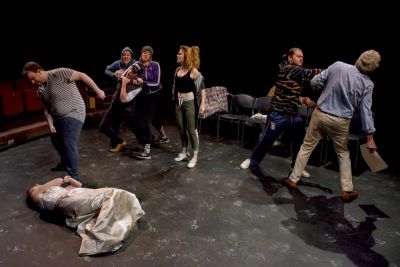Don Juan in Soho
In the era of the ‘Me Too’ movement, Director Megan Dansie is both courageous and provocative in presenting Patrick Marber’s Don Juan in Soho. Written in 2006 and updated in 2017, this play is more than a comedy. Set in modern day Soho in London, it pointedly flaunts modern hedonism by confronting the audience with a gentrified ‘twit’ who lives his life unashamedly, for his own pleasure. Played by Peter Davies, Don Juan is called DJ, but we all know who he is.
The script is acerbic, witty and biting, skillfully weaving pathos and comedy. It brings together a very unlikable lead character with ‘puppets of his pleasure’, and a disenfranchised male servant, Stan, played by Matt Houston. The text is raunchy and full of coarse language and suggestions and simulations of sex. Audience is warned about this when booking.
It is based on Moliere's highly controversial 1665 play where the libertine Don Juan is somewhat of a mirror to Parisian upper class society. Despite his grisly condemnation to hell, he subsequently became a romantic model for generations of amorous French males, including the equally infamous Casanova. Even the characters’ names in Don Juan in Soho are reflective of Moliere’s original work.
Dansie has used the intimate Little Theatre stage cleverly, moving characters well, often creating a ‘stage within a stage’ to enable the play to be delivered in both ‘Moliere style’ and in a creative modern style. The play cleverly uses this style where characters speak directly to the audience, taking them into their confidence. This works particularly well in this theatre.
The set is minimalistic with little furniture to interfere with the story telling. The lighting is appropriate and effective when used to bring ‘the statue’ to life. But saying more would be a ‘spoiler’.
 For me, the music did not add anything to the story, particularly the celebrative ending.
For me, the music did not add anything to the story, particularly the celebrative ending.
On occasions, dialogue was indistinct when characters had their back to the audience, a common challenge in theatre in the round.
The star of the show is undoubtedly Houston. He has a skilled comedic style and is to be commended for treating this play as intended, as a comedy. He has very good timing and uses his physicality well. He elicits pathos and invites the audience to laugh at the genuinely funny. He is the only character that the audience can like and empathise with.
Seasoned actor Davies has his finest moments with a poignant soliloquy at the end of the play when ‘looking death in the face’. He heaps scorn on modern society and is totally unapologetic for his life and actions. Davies is ‘word perfect’ and delivers the lines seamlessly (and there are many!). His best work is in his lower register. He tends to use a farcical style, rather than comedy and this is at odds with the laid back sleaziness of DJ’s character. The play is billed as sexy and salacious and the responsibility for this lays at the feet of DJ. Davies does not deliver this convincingly.
 The supporting actors are inconsistent and their accents are patchy and markedly not English, when required. Simulated sex scenes, rather than a raunchy romp, are awkward and comedic, adding little to DJ’s sexy demeanor and lifestyle or the intended licentiousness in the story. Several of the actors used a declamatory style, but delivered lines, partly hunched, and often looking at the floor. It was opening night, but coherence and ‘light and shade’ in performances, in the main, is yet to develop.
The supporting actors are inconsistent and their accents are patchy and markedly not English, when required. Simulated sex scenes, rather than a raunchy romp, are awkward and comedic, adding little to DJ’s sexy demeanor and lifestyle or the intended licentiousness in the story. Several of the actors used a declamatory style, but delivered lines, partly hunched, and often looking at the floor. It was opening night, but coherence and ‘light and shade’ in performances, in the main, is yet to develop.
Kate Van Der Horst had a difficult role as a slutty, opportunistic money grabber who performs fellatio on stage. This is meant to be humorous. Rather, it is unconvincing. Her flamboyance hampers her sexiness and creates somewhat of a 1960’s style ‘loose woman’ character that is out of place and time in this production.
This play has divided critics and audiences overseas, and is likely to do so here. This is a beautifully written script, full of nuance and modern day relevance that deserves to be seen and debated. The message is universal and full of portent for us all.
Jude Hines
Subscribe to our E-Newsletter, buy our latest print edition or find a Performing Arts book at Book Nook.

